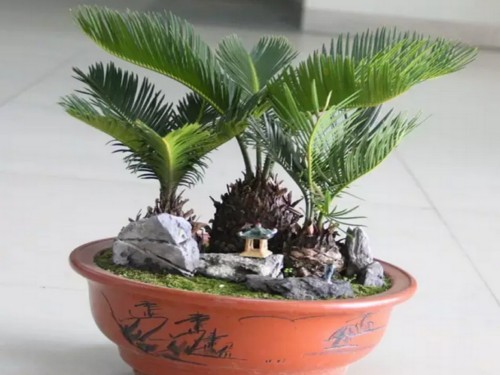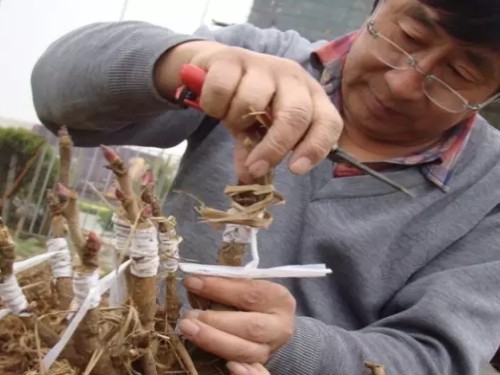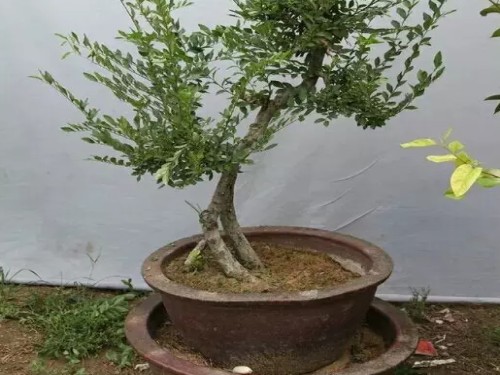What kind of breeding does Cycas use?-Propagation methods of Cycas.
Iron tree originated in south-central China, India, Japan and Indonesia, and originated in East and Southeast Asia. Zhejiang, Jiangxi, Hunan, Sichuan and other places are widely cultivated; North China, Northwest China and other places as potted plants for indoor viewing. Cycads like sunshine, dry and ventilated environment, not cold-resistant, good fertilizer, like sandy soil, slow growth.
Cycads can be as high as 8 meters in the country of origin, indoor potted plants up to 3 meters high, the stem is thick cylindrical, unbranched, with thick leaf scars, forming fish scales. The leaf cluster is born at the top of the stem and is a large pinnate compound leaf, about 1 meter long. Leaflets linear, leathery, tip hard, dark green glossy, leaf margin revolute. Every spring, the old leaves fall off one after another; the flowers are unisexual, born at the top of the stem, dioecious, and the male flowers are spirally arranged in the shape of a pineapple, covered with pilose hairs, fresh yellowish at the beginning and brown after maturity. The female flower is larger, with many palmate scales, flattened in shape and gradually divided into a pine tower. Cycads rarely bloom, 20-or 30-year-old trees can blossom, so it is called "Millennium Iron Tree flowering", flowering from June to August.

Cycad, also known as iron tree, its thick green pinnate leaves are a good material for the art of flower arrangement. Use its small plants to make bonsai, the ornamental effect is better, deeply loved by bonsai lovers. The reproduction of cycad can be divided into three methods: sowing method, plant division method, tillering method and cutting method. The tillering method is the most suitable for family pot cultivation.
Time: early May.
Second, slotting machine: the bottom layer is covered with 5 cm thick river sand, and the upper layer is a mixture of 1ax 3 river sand and 2pm 3 humus, 15 cm thick. After laying, drench thoroughly with 3 ‰ potassium permanganate solution, cover it strictly with plastic film, and use it after 1-2 days.
Third, the method: choose to tiller in cloudy days.
1. The leaves of tillering buds to be cut are cut off from the roots.
2. Remove the tillering buds from the matrix with a knife or saw, cut as small as possible, keep those with aerial roots as far as possible, and cut them short if they are too long.
3. Smear the cut tiller bud masonry mouth with plant ash and place it in a cool and ventilated place for 3-5 days.
4. The dried tillering buds were soaked in ‰ potassium permanganate solution and disinfected for 10 minutes. Peel off the soil and bury the tiller buds, not too deep, just cover the incision.
Fourth, management: there is no need to water after insertion, because the soil has just been disinfected, it is necessary to build a plastic arch shed in time to prevent rain and sunscreen. After one month, the tillering bud will produce several rounds of neat and green new leaves and begin to root. After the root system is more prosperous, you can pour light bran cake water and fertilizer, the number of times should not be too much. At this time, the arch shed can be removed and let it grow naturally. Finally, with a flowerpot wooden frame, the cycad bonsai is finished.
In addition, the editor also introduces other reproduction methods of cycads, mainly sowing and breeding methods and ramet breeding methods.
First, sowing and reproduction
1. Seed collection
Cycas seeds were harvested in October or full seeds for no more than two years.
2. Soaking seeds
Soak in about 50 ℃ warm water for 24 hours, then soak in dilute hydrochloric acid or dilute sulfuric acid for 10 minutes for 15 minutes, then rinse clean with clean water, and change clean water every other day when soaking seeds.
3. Peeling
After the seed coat is completely swollen and softened, the outer seed coat is peeled off manually, the pulp is washed, the seeds are dried, and then stored.
4. Sand storage
Seed sand storage treatment was carried out around December. Because of its thick and hard seed skin, it can be treated by variable temperature method and finally stored in sand.
5. Sowing seeds
Use clean sandy loam, river sand, perlite and other materials with good water conservation and permeability to make the seeding bed with a thickness of not less than 40 cm. Sow the prepared seeds into the bed at a distance of 5 to 20 ℃ cm, with a depth of about 3 cm. Then cover the river sand with a thickness of 3 cm, depending on the dryness of the soil and fine sand on the bed, control the amount of water, and then cover the plastic film for moisturizing and heat preservation, open the film once a week on a sunny morning, the soil should be watered to keep moist, and cover the film at sunset in the afternoon. Generally, it takes 4 to 6 months for cycads to store sand. During this period, the temperature and humidity of the sand should be maintained and the appropriate temperature is required to be 18: 25 ℃. The relative humidity is 800.90%. To keep warm in winter, it should not be lower than 12 ℃. In the second year, from May to June, the seeds germinated and broke their shells, and from July to August, they germinated and grew a true leaf.
2. Separate plant propagation
Ramet propagation should be in summer, separate the sucking bud from the stem of the mother plant, insert it into the open field or basin, and bury half of the soil, the survival rate of ramet reproduction can reach 8090%, and the sucking bud grows slowly. It is best to separate the sucking bud after 3 years, and it is easy to live if the sucking bud wound is small. Cadres can also be cut into sections of 15 to 20 centimeters long and buried in sandy soil so that they can regenerate new buds around the cadres and then be planted and cultivated.
Cycads are suitable for growing in direct sunlight or bright scattered light. It is best to be semi-shaded in summer, the temperature is maintained at 15-20 ℃, and the soil and air humidity is higher, so the leaves should be sprayed frequently. The plant has no dormant period, the suitable winter temperature is 12-16 ℃, and the plant has a considerable degree of cold resistance. During the period of 3-9 ℃, liquid fertilizer should be applied once a month, and the suitable cultivation medium should be the mixture of organic soil, mud carbon and fine sand. The basin soil is changed every 2-3 years, and new soil and base fertilizer are added to help growth.
The application of liquid fertilizer several times in summer and the addition of ferrous sulfate solution can make the leaf color greener. After autumn, the diseases and insect pests of cycads with reduced watering water are the most common, and the leaves damaged by scale insects should be kept well ventilated at first. After the discovery of shell insects, observe the spray stone sulfur mixture or fluoroacetylammonium during the incubation period.
Time: 2019-06-10 Click:
- Prev

Grafting technique of ornamental peony-grafting method of peony flower
China's peony export ranks first in the world, accounting for about 70% of the total. The export volume of Heze peony accounts for about 80% of the country's total exports, which is worthy of the name of the world's first peony distribution center. The export volume of peony and peony is about 3.5 million trees every year, of which peony accounts for about half.
- Next

Pruning skills of Lang Elm Bonsai
The dried elm is slightly curved, the bark is mottled and elegant, the twigs are graceful, and the autumn leaves turn red. It is a good ornamental tree and factory greening, greening tree species on all sides, often planted alone into a scene, suitable for planting near the pond and pavilions, but also between mountains and rocks, but there are more diseases and insect pests. It has strong sprouting power and is a good material for making bonsai.
Related
- Fuxing push coffee new agricultural production and marketing class: lack of small-scale processing plants
- Jujube rice field leisure farm deep ploughing Yilan for five years to create a space for organic food and play
- Nongyu Farm-A trial of organic papaya for brave women with advanced technology
- Four points for attention in the prevention and control of diseases and insect pests of edible fungi
- How to add nutrient solution to Edible Fungi
- Is there any good way to control edible fungus mites?
- Open Inoculation Technology of Edible Fungi
- Is there any clever way to use fertilizer for edible fungus in winter?
- What agents are used to kill the pathogens of edible fungi in the mushroom shed?
- Rapid drying of Edible Fungi

